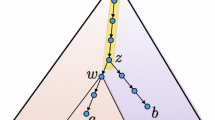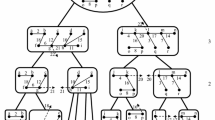Abstract
The problem of two edge-disjoint paths is to identify two paths \(Q_1\) and \(Q_2\) from source \(s \in V\) to target \(t \in V\) without any common arc in a directed connected graph \(G=(V, E)\). In this paper, we present an adaptive stabilizing algorithm for finding a pair of edge-disjoint paths from s to t in G in O(D) rounds with state-space complexity of \(O(log\; n)\) bits per process, where n is the number of nodes and D is the diameter of the graph. The proposed algorithm is optimal with respect to its time complexity, and the total length of the shortest paths. In addition, it can also be used to solve the problem for undirected graphs. Since the proposed algorithm is stabilizing, it does not require initialization and is capable of withstanding transient faults. We view a fault that perturbs the state of the system but not its program as a transient fault. In addition, the proposed algorithm is adaptive since it is capable of dealing with topology changes in the form of addition/removal of arcs and/or nodes as well as changes in the directions of arcs provided that two edge-disjoint paths between s and t exist after the topology change.




Similar content being viewed by others
References
Al-Azemi FM, Karaata MH (2011) Brief announcement: a stabilizing algorithm for finding two edge-disjoint paths in arbitrary graphs. In: Proceedings of the 13th International Conference on Stabilization, Safety, and Security of Distributed Systems, SSS’11, (Berlin, Heidelberg), Springer-Verlag, pp 433–434
Lengauer T (2012) Combinatorial algorithms for integrated circuit layout. Springer Science & Business Media, Berlin
Hsu CC (2013) A genetic algorithm for maximum edge-disjoint paths problem and its extension to routing and wavelength assignment problem, Ph.D. Thesis. NC State University, pp 17–22
Murthy S, DSouza RJ, Varaprasad G (2012) Digital signature-based secure node disjoint multipath routing protocol for wireless sensor networks. IEEE Sens J 12(10):2941–2949
Ma C, Zhang J, Zhao Y, Yuan J, Huang S, Gu W, Wang Y, Ding H, Lu L (2013) Pre-configured multi-dimensional protection (p-mdp) structure against multi-failures in high-degree node based optical networks. In: Proceedings of the 8th International ICST Conference on Communications and Networking in China (CHINACOM), IEEE, pp 756–760
Kamal AE (2010) 1+ N network protection for mesh networks: network coding-based protection using p-cycles. IEEE/ACM Trans Networking 18(1):67–80
Hadid R, Karaata M (2009) An adaptive stabilizing algorithm for finding all disjoint paths in anonymous mesh networks. Comp Commun 32(5):858–866
Dijkstra EW (1974) Self-stabilizing systems in spite of distributed control. Commun ACM 17(11):643–644
Chen CY, Wang CP, Huang TC, Lin JC (2013) Correctness of self-stabilizing algorithms under the dolev model when adapted to composite atomicity models. In: Advances in Intelligent Systems and Applications, Vol. 2, Springer, pp 573–586
Kakugawa H, Yamashita M (2005) A dynamic reconfiguration tolerant self-stabilizing token circulation algorithm in ad-hoc networks. In: Proceedings of the 8th International Conference on Principles of Distributed Systems, OPODIS’04, (Berlin, Heidelberg), Springer-Verlag, pp 256–266
Goddard W, Srimani PK (2013) Daemon conversions in distributed self-stabilizing algorithms. In: WALCOM: Algorithms and Computation, vol. 7748 of Lecture Notes in Computer Science, Springer Berlin Heidelberg, pp 146–157
Trejo-S’nchez JA, Fern’ndez-Zepeda JA (2012) A self-stabilizing algorithm for the maximal 2-packing in a cactus graph. In: Parallel and Distributed Processing Symposium Workshops & PhD Forum (IPDPSW), 2012 IEEE 26th International, IEEE, pp 863–871
Wang G, Wang H, Tao X, Zhang J (2013) A self-stabilizing protocol for minimal weighted dominating sets in arbitrary networks. In: Proceedings of the 2013 IEEE 17th International Conference on Computer Supported Cooperative Work in Design (CSCWD), IEEE, pp 496–501
Awerbuch B, Patt-shamir B, Varghese G (1991) Self-stabilization by local checking and correction (extended abstract). In: Proceedings of 32nd Annual IEEE Symposium on Foundations of Computer Science, IEEE Computer Society Press, pp 268–277
Berns A, Ghosh S, Pemmaraju SV (2013) Building self-stabilizing overlay networks with the transitive closure framework. Theor Comp Sci 512:2–14
Datta A, Devismes S, Larmore L (2009) A self-stabilizing o(n)-round k-clustering algorithm. In: Proceedings of the 28th IEEE International Symposium on Reliable Distributed Systems. SRDS ’09, pp 147–155
Cournier A, Datta AK, Petit F, Villain V (2005) Optimal snap-stabilizing PIF algorithms in un-oriented trees. J High Speed Netw 14(2):185–200
Suurballe J (1974) Disjoint paths in a network. Networks 4(2):125–145
Suurballe JW, Tarjan RE (1984) A quick method for finding shortest pairs of disjoint paths. Networks 14(2):325–336
Bhandari R (1997) Optimal physical diversity algorithms and survivable networks. In: Proceedings of the Second IEEE Symposium on Computers and Communications, IEEE, pp 433–441
Itai A, Rodeh M (1988) The multi-tree approach to reliability in distributed networks. Info Comp 79(1):43–59
Gardner ML, Loobeek IS, Cohn SN (1987) Type-of-service routing with loadsharing. In: Proceedings of the IEEE/IECE Global Telecommunications Conference, pp 1144–50
Ogier RG, Rutenburg V, Shacham N (1993) Distributed algorithms for computing shortest pairs of disjoint paths. IEEE Trans Info Theor 39(2):443–455
Sidhu D, Nair R, Abdallah S (1991) Finding disjoint paths in networks. In: ACM SIGCOMM Computer Communication Review, ACM, vol 21, pp 43–51
Rachid H, Karaata MH, Villain V (2014) Brief announcement: a stabilizing algorithm for finding two node-disjoint paths. In: Proceedings of Stabilization, Safety, and Security of Distributed Systems: 16th International Symposium, SSS 2014, Paderborn, Germany, September 28–October 1, 2014, Springer, vol 8756, p 359
Zhang K, Yin G, Han Q, Lin J (2014) Dfdp: a distributed algorithm for finding disjoint paths in wireless sensor networks with correctness guarantee, vol 2014. Hindawi Publishing Corporation, Cairo
Arabnia HR (1995) A distributed stereocorrelation algorithm. In: Computer Communications and Networks, 1995. Proceedings., Fourth International Conference on, IEEE, pp 479–482
Bhandarkar SM, Arabnia HR (1995) The refine multiprocessortheoretical properties and algorithms. Parallel Comput 21(11):1783–1805
Arabnia HR, Smith JW (1993) A reconfigurable interconnection network for imaging operations and its implementation using a multi-stage switching box. In: Proceedings of the 7th annual international high performance computing conference. pp. 349–357
Wani MA, Arabnia HR (2003) Parallel edge-region-based segmentation algorithm targeted at reconfigurable multiring network. J Supercomp 25(1):43–62
Arabnia HR (1990) A parallel algorithm for the arbitrary rotation of digitized images using process-and-data-decomposition approach. J Parallel Distributed Computing 10(2):188–192
Arabnia HR, Oliver MA (1989) A transputer network for fast operations on digitised images. In: Computer graphics forum, Wiley Online Library, vol. 8, pp 3–11
Bhandarkar SM, Arabnia HR (1995) The hough transform on a reconfigurable multi-ring network. J Parallel Distributed Computing 24(1):107–114
Arabnia HR, Oliver MA (1987) A transputer network for the arbitrary rotation of digitised images. Comput J 30(5):425–432
Arabnia HR, Bhandarkar SM (1996) Parallel stereocorrelation on a reconfigurable multi-ring network. J supercomputing 10(3):243–269
Arabnia HR. Oliver MA (1987) Arbitrary rotation of raster images with simd machine architectures. In: Computer Graphics Forum, Wiley Online Library, vol 6, pp 3–11
Bhandarkar SM, Arabnia HR, Smith JW (1995) A reconfigurable architecture for image processing and computer vision. Int J Pattern Recog Artificial Intell 9(02):201–229
Karaata MH, Chaudhuri P (1999) A self-stabilizing algorithm for bridge finding. Distributed Computing 12(1):47–53
Christian G, Nicolas H, David I, Colette J (2014) Disconnected components detection and rooted shortest-path tree maintenance in networks. In: Stabilization, Safety, and Security of Distributed Systems, Springer, pp 120–134
Blin L, Fraigniaud P (2015) Space-optimal time-efficient silent self-stabilizing constructions of constrained spanning trees. In: Proceedings of the IEEE 35th International Conference on Distributed Computing Systems (ICDCS), IEEE, pp 589–598
Author information
Authors and Affiliations
Corresponding author
Additional information
A proposal of this research work appeared in [1]. This research was supported by Kuwait University Research Grant EO 06/11.
Rights and permissions
About this article
Cite this article
Karaata, M.H., Alazemi, F.M. An optimal adaptive stabilizing algorithm for two edge-disjoint paths problem. J Supercomput 73, 1257–1273 (2017). https://doi.org/10.1007/s11227-016-1809-5
Published:
Issue Date:
DOI: https://doi.org/10.1007/s11227-016-1809-5




